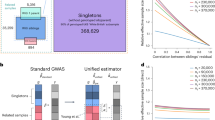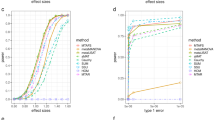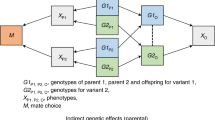Abstract
Recently, Steen et al proposed a two-stage approach for genome-wide family-based association studies. In the first stage, a screening test is used to select markers, and in the second stage, a family-based association test is performed on a much smaller set of the selected markers. The two-stage method can be much more powerful than the traditional family-based association tests. In this article, we extend the approach so that it can incorporate parental information and can be applied to an arbitrary pedigree structure. We use simulation studies to evaluate the type I error rates and the power of the proposed methods. Our results show that the two-stage approach that incorporates founders' phenotypes has the correct type I error rates, and is much more powerful than the two-stage approach that uses children's phenotypes only. Also, by carefully choosing the number of markers retained in the first stage, the power of a two-stage approach can be much more than that of the corresponding one-stage approach.
Similar content being viewed by others
Log in or create a free account to read this content
Gain free access to this article, as well as selected content from this journal and more on nature.com
or
References
Steen KV, McQueen MB, Herbert A et al: Genomic screening and replication using the same data set in family-based association testing. Nat Genet 2005; 37: 683–691.
Risch N : Searching for genetic determinants in the new millennium. Nature 2000; 405: 847–856.
Hirschhorn JN, Daly MJ : Genome-wide association studies for common diseases and complex traits. Nat Rev Genet 2005; 6: 95–108.
Benjamini Y, Hochberg Y : Controlling the false discovery rate: a practical and powerful approach to multiple testing. J R Stat Soc B 1995; 57: 289–300.
Satagopan JM, Elston RC : Optimal two-stage genotyping in population-based association studies. Genet Epidemiol 2003; 25: 149–157.
Wang H, Thomas DC, Peer I, Stram DO : Optimal two-stage genotyping designs for genome-wide association scan. Genet Epidemiol 2006; 30: 356–368.
Lange C, Demeo D, Silvermen EK, Weiss ST, Laird NM : Using the noninformative families in family-based association tests: a powerful new testing strategy. Am J Hum Genet 2003; 73: 801–811.
Zhang S, Zhang K, Li J, Sun FZ, Zhao H : Test of linkage and association for quantitative traits in general pedigree: the quantitative pedigree disequilibrium test. Genet Epidemiol 2001; 18 (Suppl 1): 370–375.
Spielman RS, Ewens WJ : A sibship test for linkage in the presence of association: the sib transmission/disequilibrium test. Am J Hum Genet 1998; 62: 450–458.
Bickeboller H, Clerget-Darpoux F : Statistical properties of the allelic and genotypic transmission/disequilibrium test for multiallelic markers. Genet Epidemiol 1995; 12: 865–870.
Sham PC, Curtis D : An extended transmission/disequilibrium test (TDT) for multi-allele marker loci. Ann Hum Genet 1995; 59: 323–336.
Schaid DJ : General score tests for associations for genetic markers with disease using cases and their parents. Genet Epidemiol 1996; 13: 423–449.
Sun F, Flanders WD, Yang Q, Khoury MJ : Transmission disequilibrium test (TDT) when only one parent is available: the 1-TDT. Am J Epidemiol 1999; 150: 97–104.
Martin ER, Monks SA, Warren LL, Kaplan NL : A test for linkage and association in general pedigree: the pedigree disequilibrium test. Am J Hum Genet 2000; 67: 146–154.
Allison DB : Transmission-disequilibrium test for quantitative traits. Am J Hum Genet 1997; 60: 676–690.
Rabinowitz D : A transmission disequilibrium test for quantitative trait loci. Hum Hered 1997; 47: 342–350.
Schaid DJ, Rowland CR : The use of parents, sibs, and unrelated controls to detection of associations between genetic markers and disease. Am J Hum Genet 1998; 63: 1492–1506.
Monks SA, Kaplan NL : Removing the sample restrictions from family-based test of association for quantitative trait locus. Am J Hum Genet 2000; 66: 576–592.
Zhang S, Sha Q, Chen HS, Dong J, Jiang R : Transmission/disequilibrium test based on haplotype sharing for tightly linked markers. Am J Hum Genet 2003; 73: 566–579.
Morley M, Molony CM, Weber T et al: Genetic analysis of genome-wide variation in human gene expression. Nature 2004; 430: 743–747.
Hudson RR : Generating samples under a Wright–Fisher neutral model of genetic variation. Bioinformation 2002; 18: 337–338.
Nordborg M, Tavare S : Linkage disequilibrium: what history has to tell us? Trends Genet 2002; 18: 83–90.
Kimmel G, Shamir R : A fast method for computing high significance disease association in large population-based studies. Am J Hum Genet 2006; 79: 481–492.
Clerget-Darpoux F, Elston RC : Are linkage analysis and the collection of family data dead? Prospects for family studies in the age of genome-wide association. Hum Hered 2007; 64: 91–96.
Acknowledgements
This work was supported by National Institute of Health (NIH) Grants R01 GM069940, R03 HG 003613, R01 HG003054, and R03 AG024491.
Author information
Authors and Affiliations
Corresponding author
Rights and permissions
About this article
Cite this article
Feng, T., Zhang, S. & Sha, Q. Two-stage association tests for genome-wide association studies based on family data with arbitrary family structure. Eur J Hum Genet 15, 1169–1175 (2007). https://doi.org/10.1038/sj.ejhg.5201902
Received:
Revised:
Accepted:
Published:
Issue date:
DOI: https://doi.org/10.1038/sj.ejhg.5201902
Keywords
This article is cited by
-
Two-stage family-based designs for sequencing studies
BMC Proceedings (2014)
-
A modified two-stage approach for family-based genome-wide association studies
European Journal of Human Genetics (2014)



